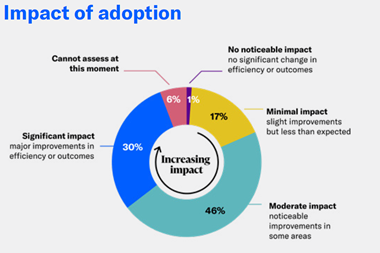Some US risk managers are facing more than the foreseeable hard D&O market conditions. They are experiencing the end of D&O insurance as we know it, warns Michael A Rossi
USrisk managers with D&O renewals in the latter part of 2002 are facing increasingly tough times in terms of pricing and coverage. And some UK risk managers suspect that the changes taking place in the US D&O market might spill over to the UK D&O market in 2003, if not sooner. My discussions with US risk managers show that the market is taking a dramatic turn for the worse. Many are facing some or all of the following issues.
Entity coverage is no more Some US risk managers were not able to renew with entity coverage in their programmes. Large tech companies and non-tech companies with large market capitalisations are having the most difficulty. But I predict that more and more companies in all industries will have a difficult, if not impossible, time securing entity coverage for any claim, let alone 'securities claims'. For example, AIG's new main D&O policy form in the US, launched in October, does not provide entity coverage.
Severability as to exclusions removed Some of the new D&O wordings in the market expressly do not provide severability as to certain of the 'conduct' exclusions (eg for fraud or dishonesty). How can insurers sell D&O insurance that does not have severability as to the exclusions? It is easy. They are saying that they do not want to pay anything in an Enron or WorldCom situation. And, perhaps more importantly, this is one way for such insurers to create a demand for their new D&O insurance products – excess/difference-in-conditions side-A insurance and independent directors liability insurance. More information on that is provided below.
Severability as to the application for insurance removed In some of the new D&O wordings, if one insured person has knowledge of something that is a mis-statement in, or omission from, the application for insurance, the policy can be rescinded as to all insureds. Rescission is a very problematic situation, because it voids the policy ab initio, so that the policy is treated as never coming into existence. The reasons why carriers are doing this are the same as those for removing severability as to exclusions – to avoid paying out anything in an Enron or WorldCom type of claim, and to create demand for their other D&O insurance products.
Co-insurance obligations for corporate indemnification coverage The insurers want companies to have 'skin in the game' so that they don't just offer up the insurance limits in settlement, but fight on, as a 'partner' with the D&O insurer. Expect to see co-insurance percentages in the 20% to 40% range, or more (AIG's new D&O policy in the US subjects the side-B cover to a 50% co-insurance obligation!).
Importantly, this will not be entity coverage with a co-insurance obligation. It will be corporate indemnification insurance (covering the corporation's obligation to indemnify directors and officers), with a functional predetermined allocation provision (the co-insurance clause). This is a very important distinction, because it means that, in order for the corporate insured to be entitled to any insurance coverage, at least one director or officer must remain a party in the lawsuit and the company must have an indemnity obligation with respect to that director or officer. Ironically, this builds into the process an incentive not to get directors and officers dismissed from lawsuits.
Corporate indemnification coverage becomes illusory Some insurers are imputing so many different directors' and officers' acts to the corporate insured, that corporate indemnification coverage becomes illusory. For example, some of the new wordings provide that, if the corporate insured has to indemnify 'innocent' officer A because officer B committed fraud, officer B's conduct will be imputed to the corporate insured to bar coverage for the company's indemnity obligation to Officer A. What kind of coverage is that? Again, it is coverage that is not going to respond to an Enron or WorldCom situation.
A litany of narrowing provisions added by endorsement The foregoing are some of the 'big picture' issues. The following are samples of the many new restrictions being imposed at renewal by several insurers: secondary offering exclusion; failure to maintain insurance exclusion; unilateral discovery period with only one option – one year for 200% of the annual premium; short-swing profits exclusion; exclusion of claims by trustee, liquidator, creditors, etc in bankruptcy, and exclusion of claims arising out of a restatement of financials. The list goes on.
D&O insurance gets even more expensive What we used to think of as rates on line only for specialty products like representation and warranty insurance, loss mitigation insurance and the like – between 8%and 12% rate on line – will become the norm for D&O insurance. Expect to pay between $80,000 to $120,000 per million of insurance. US risk managers used to pay about $10,000 per million for D&O insurance, at the primary layer. Those days are long gone.
Price increases affecting much more than the primary layer Not only were US risk managers paying about $10,000 per million for the primary layer, they were paying much less than that for their excess layers, so that a $100m limit programme could be purchased for under $1m in premium. Now, however, US risk managers are being asked to pay $5m in premium for a $100m limit programme. Why? Because more and more excess carriers are asking for 85% or more of the rate on line paid to the primary carrier. This is happening so much now in the US that some primary carriers are putting contingency clauses in their quotes that provide that they can increase their price if the rate paid to any carrier writing excess of them on the account is higher than the rate paid to them. This is becoming a real problem, with costs spiralling out of control for some US risk managers trying to buy a programme with more than about $70m in limits.
Worldwide capacity is diminishing Even if a company can afford these incredible prices, it might, nevertheless, be unable to buy a programme with the amount of limits for which it is willing to pay. That is because more and more insurers can write only $10m per account (rather than the $25m or more they used to be able to write), and some insurers are leaving the D&O marketplace.
little-known D&O products are pushed on risk managers The insurers' excess side- A/difference-in-conditions (DIC) and independent directors liability (IDL) insurance are being touted by some as the 'cure all'. The excess side-A/DIC policy is not really new. ACE (through a subsidiary in Bermuda called CODA), has been selling the insurance for years. It responds to non-indemnifiable loss in certain situations when the underlying insurance does not respond, and to indemnifiable loss in certain situations where the company either refuses to pay or is financially unable to pay.
IDL insurance appears to be relatively new. It could prove very interesting, in that the CODA form of it deletes all the conduct exclusions (fraud/dishonesty, profit or advantage, short swing profits). I am not aware of any other insurer doing that yet, but more insurers might well follow suit to further entice companies or natural persons to buy the product. And there are two different ways to buy IDL insurance. The company can buy it for all of its independent directors, or a natural person can buy it for him or herself, insuring his or her exposure with respect to all of the companies for which the person serves as a director.
What can you do?
Set expectations Do not let yourself be fooled into thinking that all is going to be OK. Expect the worst, and plan contingencies. Consider yourself lucky if you come through your 2002 and 2003 renewals with some meaningful coverage that you can afford.
Understand what you are buying You must read every word of the new endorsements and policy forms being used by the insurers. Do not rely solely on the insurance brokers' summaries of coverage.
Fight to keep in severability As much effort as possible should be put into maintaining severability as to the application for insurance, and severability as to the conduct exclusions. So, if you have some silver bullets at your disposal, consider where you want to use them very carefully.
Consider exercising discovery period on expiring programme A tactic used by some risk managers and brokers faced with an impossible renewal situation on a claims-made programme is to buy the discovery period (aka extended reporting period, or 'tail') on the favourably-worded expiring programme. That extends the favourable coverage for claims arising out of acts taking place prior to policy expiration for as long as the discovery period. Because some current programmes have six or 10 year discovery periods, this might be a viable option. More risk managers faced with a dismal D&O insurance renewal are exploring this strategy.
Fully expect to buy excess/DIC side-A cover and/or IDL insurance, or to justify why you are not buying such cover
Concluding thoughts
Although I heard grumbling from AIG, Chubb and other D&O insurers in early 2002, as well as from European D&O insurers in late 2001, I never thought the US D&O insurance market would get as bad as it is now becoming. While European risk managers and some US companies may not be experiencing these problems as yet, it is important for risk managers on both sides of the Atlantic to consider these developments and plan for their D&O insurance renewals accordingly.
Michael Rossi is president of Insurance Law Group, Inc, a Los Angeles firm providing legal services to risk managers of large multinational corporations, Tel: 001 818-649-7654, E-mail: mrossi@inslawgroup.com



















